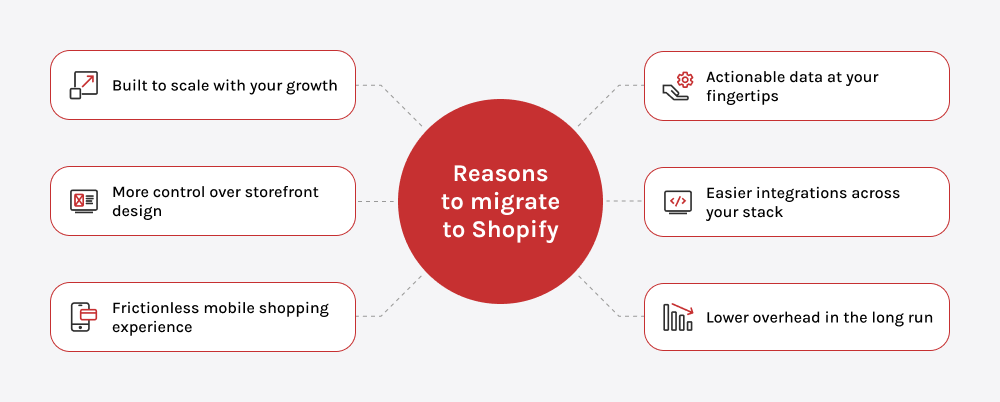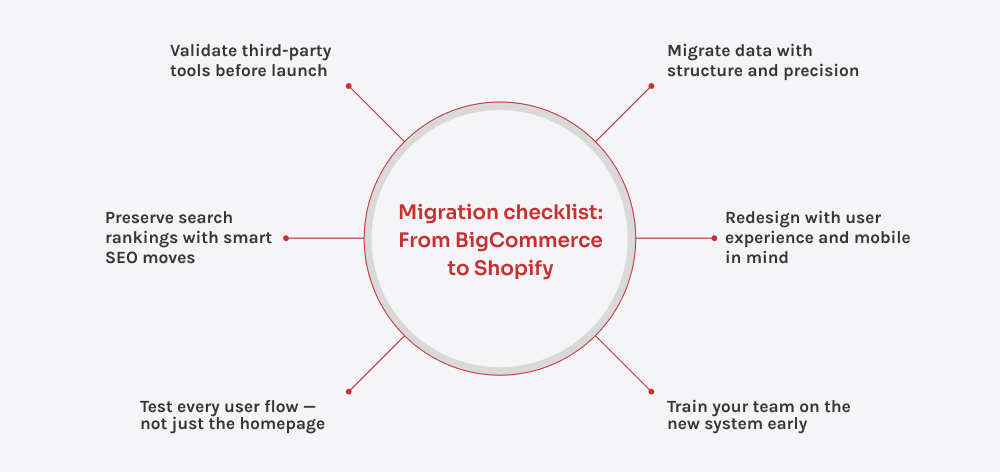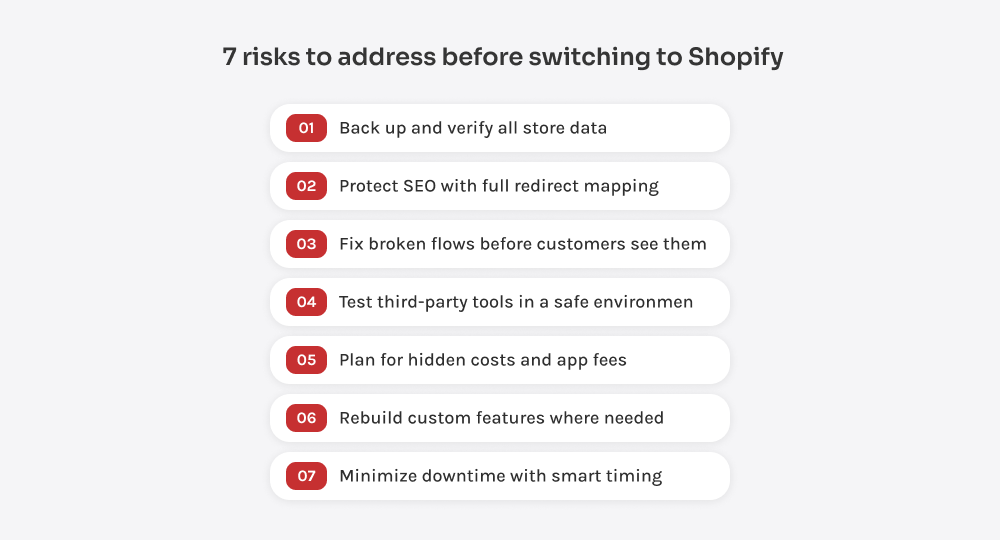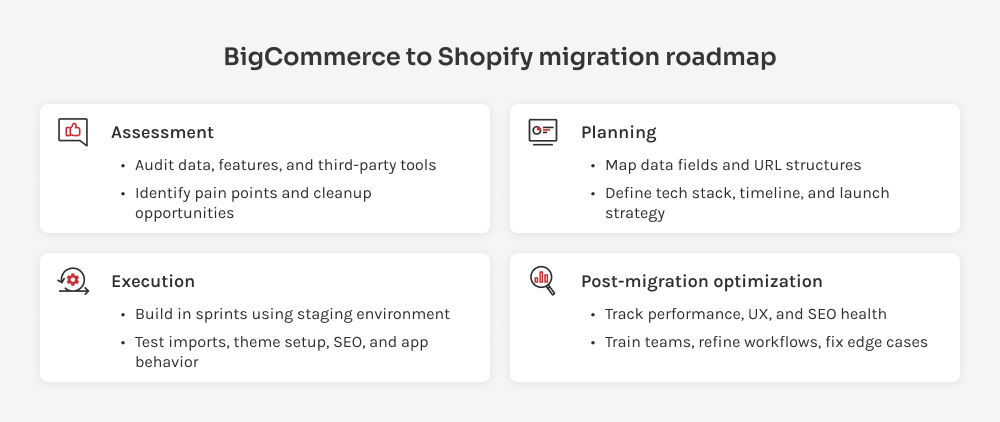Your message has been sent.
We’ll process your request and contact you back as soon as possible.
The form has been successfully submitted.
Please find further information in your mailbox.


If you’re reading this, you’re probably already a little frustrated.
Maybe BigCommerce started strong, but now it feels clunky. Too rigid. Too expensive to customize. Or maybe your marketing team keeps asking for integrations that take weeks to implement, if they’re even possible. And don’t get me started on how hard it is to scale without tripping over hidden fees.
If that hits close to home, you’re not alone. We’ve worked with clients who tried to squeeze every last drop out of BigCommerce before finally deciding: it’s time to move on. And 9 times out of 10, they land on Shopify. Not because it’s the “trendier” option, but because it gives them something most platforms can’t: control.
Control over the customer journey. Over the tech stack. Over the cost structure. Over how fast you can launch, test, pivot, and grow.
Migrating from BigCommerce to Shopify is a strategic decision. One that can cut long-term costs, open the door to more sales, and drastically improve your team’s efficiency. For C-level execs and founders, it means fewer limitations and more room to build the experience your customers expect, not the one your CMS allows.
This guide is for you if you’re leading the migration internally or partnering with an external dev team. I’ll walk through key reasons to make the switch, what data you can (and should) move, how to dodge common pitfalls, and the tactical roadmap I’ve seen work across real e-commerce projects.
In short, Shopify gives you more flexibility, better scalability, and fewer technical limitations than BigCommerce, especially as your business grows.
If you’re thinking about migrating from BigCommerce to Shopify, it’s probably not just a whim. It’s a signal that your current platform is starting to get in the way of how you want to run your business. We’ve seen this play out more times than we can count. The tools feel outdated. Customizations take forever. Scaling costs creep up without warning. And suddenly, your team is spending more time patching workarounds than actually growing the store.

Shopify is built for growth. Whether you’re adding new product lines, expanding into new markets, or handling flash-sale traffic spikes, it keeps up without breaking a sweat. No performance bottlenecks. No dev-side panic. You get flexible APIs, built-in multi-channel selling, and a backend your team won’t dread opening on Monday morning.
And when business needs shift? Shopify’s app ecosystem and integrations let you pivot fast, without hiring a full dev squad for every minor change.
If your current storefront looks like a template from 2015 — or worse, it acts like one — Shopify gives you a clean slate. Their themes are more functional, more flexible, and way easier to customize without breaking user experience in the process.
Want to guide users through a curated funnel? Done. Need to test new layouts for conversion? You’re in control. The result? A storefront that feels like your brand and performs like your best sales rep.
Here’s the uncomfortable truth: if your mobile experience is even slightly off, you’re bleeding revenue. And with BigCommerce, mobile optimization often means wrestling with outdated themes or layering plugins just to get responsive behavior.
Shopify, on the other hand, is mobile-first by design. Their themes adapt seamlessly across devices, checkout flows are optimized for thumbs, and speed is fast enough to keep customers from bouncing. It’s the kind of experience that doesn’t just look good, it sells better.
You can’t grow what you don’t track. Shopify gives you access to data that’s actually usable, not buried in confusing menus or scattered across plugins. Their analytics dashboards are clean, customizable, and deep enough to make real decisions from.
Want to see how a promo code impacted repeat purchases? Or which funnel step is leaking the most revenue? Shopify’s reports (plus integrations with tools like Google Analytics, Klaviyo, and more) make those insights accessible without hiring a data analyst.
Shopify’s app store is more mature. You’ll find vetted tools for everything from AI-driven personalization to complex ERP connectors. And these aren’t janky workarounds. They’re apps built with Shopify’s architecture in mind, which means faster setup, fewer conflicts, and actual support.
If you’ve ever lost hours debugging a half-baked integration on BigCommerce, you know how valuable that is.
Tip: Want a broader look at how Shopify stacks up against other e-commerce CMS platforms? We broke it down here in our review of the best CMSs for e-commerce.
We’ve migrated stores where teams were spending 10+ hours a week just keeping things from breaking: fixing product feeds, chasing down sync issues, rebuilding abandoned cart flows that never worked right. Shopify doesn’t eliminate complexity, but it gives you the tools to manage it without babysitting every single integration. That’s what makes the difference long-term.

Dmitry Coolgun
Head of PHP department
BigCommerce’s pricing can be deceptive. Between plan limitations, extra fees, and paid add-ons, what starts off cheap often becomes an expensive compromise. Shopify’s pricing tiers are transparent. And once you’re on Shopify Plus, you’ll notice the operational cost curve flattens instead of ballooning.
Fewer dev hours. Fewer plugin disasters. Lower payment processing fees if you use Shopify Payments. That’s real savings, not just in money, but in time.
You can migrate products, customer profiles, orders, discounts, content pages, and more from BigCommerce to Shopify. But not everything will transfer cleanly. Here’s the catch: just because something can be moved doesn’t mean it’ll map over neatly. That’s where businesses often hit a wall. To keep your operations intact post-migration, you’ll want to know what’s transferable, what needs adjustment, and what absolutely can’t be skipped.
Let’s walk through the main data categories and what to watch for.
Products are the backbone of your store, and yes, they can be migrated, but not all fields are created equal. Here’s what typically comes over:
Watch out for: Complex product options, custom fields, and variant logic. Shopify handles product variants differently than BigCommerce, so if you’re using nested options or custom modifiers, you may need to restructure how your products are set up.
Also, if you’re using trashed products in BigCommerce (like archived SKUs), they’ll likely show up as archived in Shopify, not active.
Order history is critical for both customer service and tax reporting. And yes, you can migrate it. The order data you can bring over includes:
Watch out for: Order statuses don’t always translate 1:1. You may need to map your “Awaiting Fulfillment” or “Shipped” tags into Shopify’s status logic. Also, historical payment data might not carry over depending on how payments were processed, so check with your provider.
Collections (a.k.a. categories) are fully supported, but handled differently. Shopify focuses more on automated collections (rule-based) and manual ones.
Watch out for: If you have deep nesting or parent/child category logic in BigCommerce, you’ll need to rethink your structure using tags or rules in Shopify.
This is a big one for SEO. Every single URL that’s changing should have a proper 301 redirect set up.
Watch out for: Don’t wait until after launch. Map your legacy URLs and set up redirects before the site goes live, especially for high-traffic product and category pages.
Customer records are highly portable, and Shopify lets you bring over:
Watch out for: Passwords can’t be migrated. Due to encryption differences, customers will need to reset their passwords the first time they log into your new store. This is unavoidable but manageable if you communicate it early (we’ll cover this in the risk section).
Your discount logic may need adjusting, but the core fields migrate cleanly:
Watch out for: Shopify’s discount engine is flexible but works differently from BigCommerce. Some conditional logic (like user segmentation) might need to be recreated manually or via apps.
If you’ve got About pages, shipping policies, and FAQ sections, those come too, including:
Watch out for: Formatting might break, especially if your original content used hardcoded CSS or embedded scripts. Always review imported pages visually before launch.
Blog content transfers over, including:
Watch out for: Shopify blogs are more limited than full-scale CMS platforms. If you rely heavily on dynamic blog layouts or content blocks, be prepared to adapt your formatting.
To migrate smoothly, you need to plan for data integrity, SEO preservation, UX consistency, app compatibility, and team readiness, not just the tech transfer.
Moving from BigCommerce to Shopify is basically rebuilding your store in a new ecosystem without breaking everything that was working. The tech side is only half the challenge. The real risk is operational disruption: lost orders, broken layouts, SEO drops, and confused customers. Here’s what to focus on if you want this migration to be smooth.

First things first — your data. If it’s inconsistent or incomplete, things unravel fast. Every product detail, customer profile, and order history needs to land in Shopify with accuracy and structure.
What to do:
Need help mapping the specifics? We’ve got a full post breaking down e-commerce migration — tactics, timelines, and tools included.
Your old theme isn’t coming with you. And that’s a good thing because it’s your chance to rethink the experience. But don’t just clone the layout. Shopify’s frontend is more flexible, so use that to your advantage.
What to do:
This is where even good migrations go wrong. One missed redirect or broken page can tank your rankings overnight. SEO should be planned at the same time as design and data, not slapped on afterward.
What to do:
Here’s the part most folks underestimate. You’ll probably replace some of your old BigCommerce extensions with new Shopify apps, but not all replacements are plug-and-play.
What to do:
No matter how careful your setup is, things will break. Testing is where you catch the worst of it before customers do.
What to do:
This one gets overlooked. You may be switching platforms, but your staff still has to run the store. Shopify’s admin is intuitive but different.
What to do:
Every migration comes with risk: data loss, SEO drops, downtime, broken integrations. That’s not fear-mongering, it’s reality. And sweeping those risks under the rug is exactly how projects end up delayed, over budget, or worse, live with broken customer journeys. But here’s the upside: most of the damage is avoidable if you plan for it upfront.

Let’s break down the risks that catch teams off guard and what to do about them.
It’s not just about missing SKUs. If order histories don’t migrate, customer records get scrambled, or product attributes go missing. And your team ends up scrambling for weeks. Worse, customers may lose trust if their accounts or past purchases disappear.
The non-negotiable reality: Passwords won’t transfer. That’s a platform limitation, not a bug. Shopify encrypts passwords differently, so your users will need to reset theirs.
What to do:
You’ve worked hard to earn your search rankings. But during a migration, it’s easy to break everything Google likes about your site, especially if your URLs, metadata, or structured data are changing.
What to do:
Let’s say your store launches with broken filters, missing images, or a half-working checkout. That’s not just embarrassing, it’s expensive. Customers don’t wait around. They bounce.
What to do:
One broken integration can shut down order fulfillment or freeze customer support. If you’re using ERPs, CRMs, accounting software, or shipping platforms, they need to work on day one.
What to do:
Migrations always cost more when you underestimate complexity. That plugin that “should’ve worked”? Suddenly, it needs custom dev work. That layout tweak? Now it’s a frontend rebuild.
What to do:
If you’ve built custom workflows or third-party integrations into BigCommerce, you’ll probably need to rebuild some of them on Shopify. The two platforms don’t speak the same language under the hood.
What to do:
No one wants to shut the store down. But depending on your architecture and go-live strategy, some downtime might be unavoidable.
What to do:
Migrating from BigCommerce to Shopify is a business-critical project with moving parts across data, UX, operations, and SEO. On paper, it only includes four stages — assessment, planning, execution, and post-migration — but don’t be deceived. Each one hides complexity that can derail your timeline if you’re not prepared.
Here’s the roadmap we follow, refined from years of doing this for ecommerce brands with thousands of SKUs, international fulfillment, and custom logic that can’t afford to go offline.

Think of this as your pre-flight checklist. Before anything moves, you need to know what you’re working with — and what you’re walking away from.
What to do:
This is the least glamorous phase, and the one that saves the most time later. You’re building your playbook: who’s doing what, when, and with what tools.
What to do:
You are all set to migrate BigCommerce to Shopify correctly.
Now you’re in build mode. It’s iterative. That means testing early and fixing fast.
What to do:
Once you go live, things will break. Users will find edge cases your team didn’t. That’s expected. What matters is how fast you fix, optimize, and learn.
What to do:
Pro tip: Every migration reveals things you didn’t know were broken in the old system. Use this as a reset.
Most migrations fail for one of two reasons: they’re rushed, or they’re treated like a simple content transfer. To transfer BigCommerce to Shopify is neither quick nor trivial. It’s a full-scale rebuild, and if done right, it becomes a turning point for your ecommerce operations.
You get a faster, cleaner, more flexible storefront. A backend your team can actually work with. Tools that don’t require weeks of dev time just to sync inventory or launch a discount. And in the long run, fewer hidden costs and more room to grow.
But the benefits only show up when the foundation is solid. That means detailed planning. Clean data. Real testing. A launch strategy that accounts for SEO, UX, and third-party tools.
If you want this done without the guesswork, with a team that’s handled the messy edge cases before, we’re here.

Delivery Manager in E-commerce
Volha keeps complex eCommerce projects moving without losing sight of the details. She’s great at balancing priorities, guiding teams through tight timelines, and making sure the final product actually supports the client’s business goals.












Your message has been sent.
We’ll process your request and contact you back as soon as possible.

By signing up you agree to our Privacy Policy, including the use of cookies and transfer of your personal information.